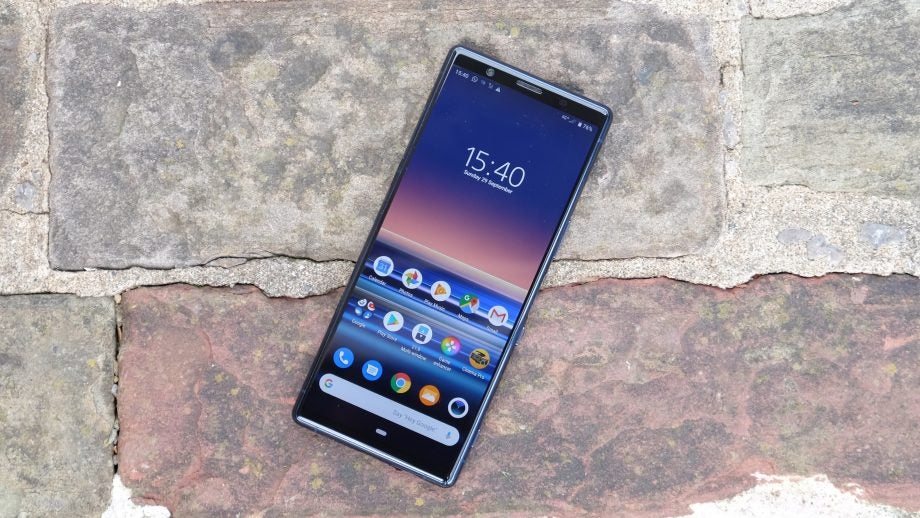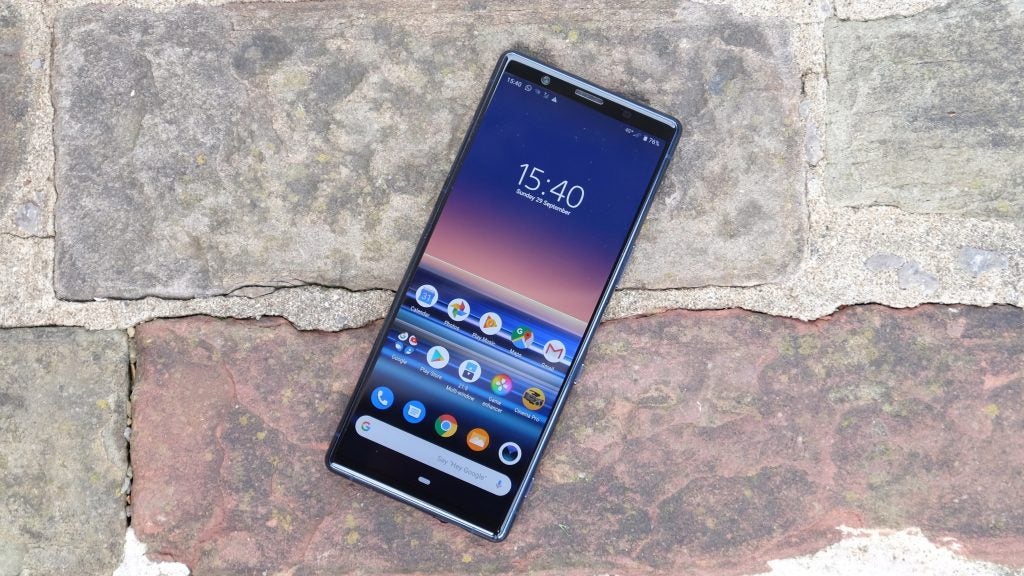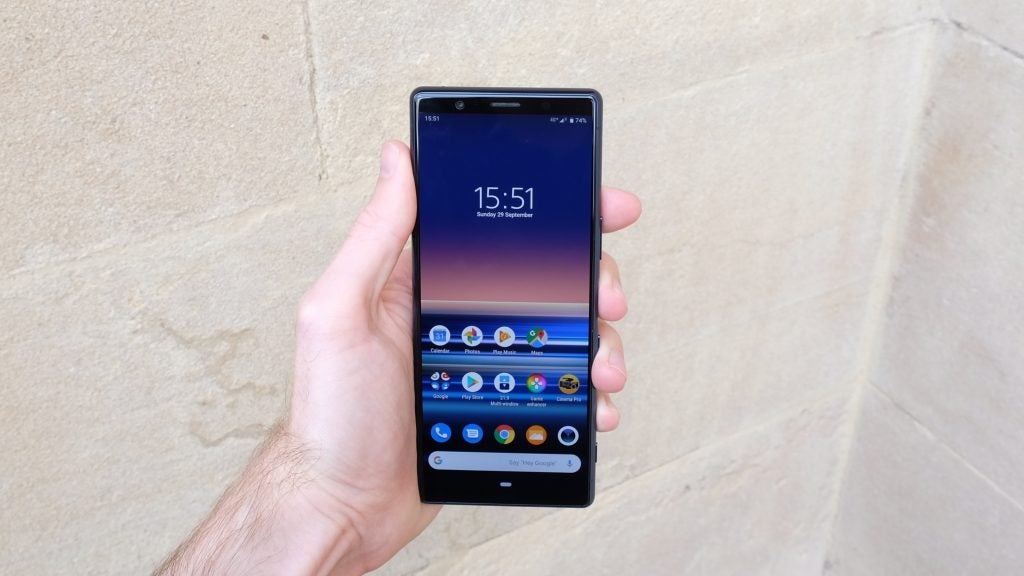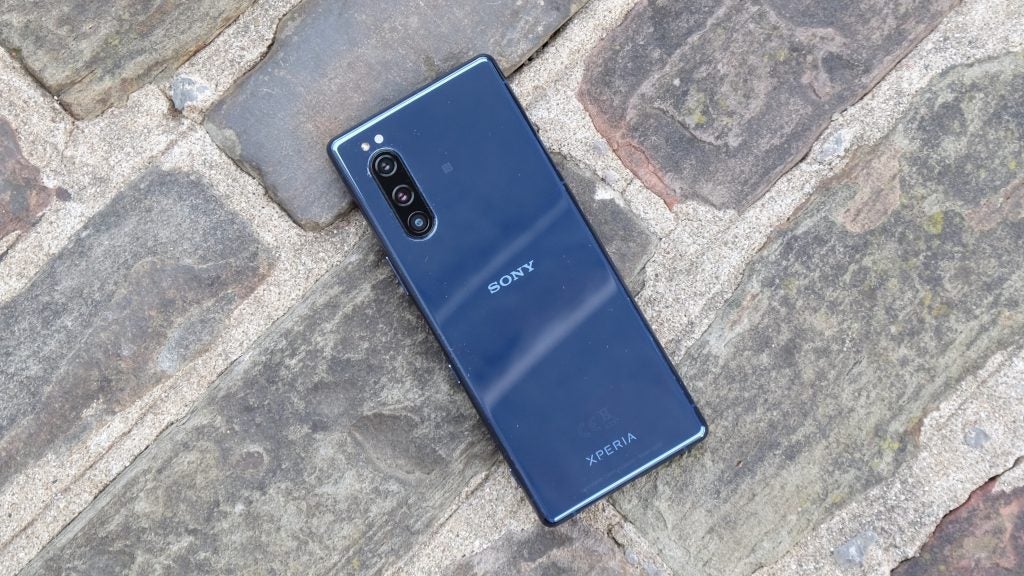Sony Xperia 5 Review
Sony Xperia 5 Review
A lower-cost Xperia 1 with an HDR super-wide screen

Verdict
Hot on the heels of the Xperia 1, the Xperia 5 is another strong flagship-level phone from Sony, this time offering a slightly better balance between top-end specifications and everyday practicality. The Xperia 5 sacrifices a little of the wow factor for a little more usability – but we’re quite happy with the trade-off.
Pros
- (Still) the best camera we’ve seen on a Sony phone
- Sony design fairly distinctive
- Balanced, attractive OLED display
Cons
- 21:9 screen has its practical drawbacks
- Camera good, but not among the best
- Strong rivals at the same price
Key Specifications
- Review Price: £699
- 6.1in 21:9 1080 x 2520 OLED
- Qualcomm Snapdragon 855 SoC
- 6GB RAM
- 64GB w/ microSD up to 512GB
- Side-mounted fingerprint sensor
- 8MP front-facing camera
- Android 9.0
The naming, timing, and specifications for the Sony Xperia 5 make it a rather tough handset to pin down. Despite its rather unhelpful nomenclature, the phone trails the Sony Xperia 1 to market by just a few months, and the two phones are unquestionably of the same generation.
However, the Xperia 5 is a slightly more discreet alternative, with one or two thoughtfully downscaled components. At just £699 it’s around £150 cheaper than the Xperia 1, making it a tempting value proposition.
We wouldn’t necessarily call the Sony Xperia 5 the Sony Xperia 1 Compact but… yes, it’s basically the Sony Xperia 1 Compact. And while we’re not entirely sure on its positioning in the wider market, it makes for a very elegant, affordable flagship option.
Sony Xperia 5 design – Tall, slippery, and a little lopsided
The most striking thing about the Sony Xperia 5 design is its height. Thanks to a 21:9 display – one of many traits it shares with its big brother – and slightly thicker top and bottom bezels, it’s far lankier than the likes of the OnePlus 7 Pro, the iPhone 11 or the Samsung Galaxy S10e.
On the positive side, a width of just 68mm means it’s easy to get your hands around it. Conversely, it’s impossible to reach a large chunk of the top of the phone with the thumb of your holding hand.
Clearly aware of this, Sony has included a number of one-handed software workarounds – but they’re just that: workarounds.
Still, I’m glad that it proves so easy to wrap your fingers around the phone, because otherwise I’m certain I’d have dropped it by now. This is one seriously slippery sucker, with a shiny glass back and glossy, slightly rounded aluminium frame.
This vague sense of awkwardness continues when you examine the right edge of the phone. Like the Xperia 1, Sony has crammed all of the Xperia 5’s key buttons onto this one side. In between the volume and power keys is a side-mounted fingerprint sensor – which, in terms of reliability, I found to be a tad hit and miss.
Further down the right side of the phone is Sony’s trademark dedicated camera shutter button. Personally, I always find this latter inclusion to be a welcome one. It’s a handy shortcut to the camera app, and it makes casual snapping feel far more tactile and purposeful than usual.

Overall, though, the right side of the Xperia 1 feels way too busy, while both the left and rear of the phone are relatively underemployed.
This is a pretty light handset at 164g – but, given its compactness, there’s a pleasing density to it all the same. It isn’t up there with the iPhone 11 or the Samsung Galaxy S10 in terms of premium look and feel, though. That isn’t helped by cheap touches such as the bottom-mounted speaker grille and a lack of texture or visual differentiation on those side buttons.
But the one thing we can say in favour of the Sony Xperia 5 design – which was the case with the Xperia 1 before it, too – is that it’s different from its rivals. That counts for a lot.
With an IP65/IP68 dust/water-resistant rating, the Xperia 5 can handle a good amount of water and dust ingress. The presence of Gorilla Glass 6 should ensure that it stands up to minor nicks and scrapes, too.
Sony Xperia 5 display – Super-wide OLED that doesn’t always get to stretch out
If you were to narrow down the difference between the Sony Xperia 5 and the Sony Xperia 1 to just one key features, it would be the display.
Rather than the huge, ridiculously pixel-packed 6.5in 4K screen of the Xperia 1, here we get a 6.1in Full HD+ display. It’s the lesser panel in a couple of key ways, then, but you’d struggle to call it markedly worse in day-to-day usage.
Crucially, this is still an OLED panel, and is therefore still capable of producing eye-pleasing levels of contrast with HDR BT.2020 support. While it might not be the absolute best OLED display you’ll find in a smartphone, the Xperia 5 benefits from Sony’s extensive standards support and image processing prowess.
By default the screen is set to Standard mode, which presents vivid colours and a cooler hue. Creator mode will kick in when the appropriate app is used, providing a more natural and warmer look, utilising the aforementioned BT.2020 colour gamut for movie content.
You can still play ultra-wide video content natively, too, thanks to that stretched-out 21:9 aspect ratio. Of course, the fact that there really isn’t all that much 21:9 video out there continues to be a significant drawback. As things stand, most of the video content you’ll encounter will be in 16:9, creating chunky borders on the Xperia 5 display.

However, getting the right Netflix movie can go some way to justifying the Xperia 5’s awkward display. Blade Runner 2049 looks absolutely stunning here.
One other negative side effect of this stretched-out display is that it can make a 6.1in display feel surprisingly pokey at times. The image might be able to go wider on occasions, but it will always be a little shorter than you might be accustomed to.
We noted in our Xperia 1 review that no phone really needs a 4K resolution, and the Xperia 5 goes to prove it. 1080 x 2520 is more than sufficient at this size, whatever the task. Indeed, it’s significantly sharper than the LCD panel of the similarly priced iPhone 11.
Sony Xperia 5 performance – Predictably speedy performance across the board
Internally, you’re getting the exact same setup as the Xperia 1, not to mention most other 2019 Android flagship phones. The combination of a Snapdragon 855 CPU with 6GB of RAM has been a winner for a number of this year’s best phones.
Sure enough, the Sony Xperia 5 flies along. As you’d expect, general navigation is stutter-free; but advanced tasks don’t seem to tax the phone, either.
Split-screen multi-tasking is one of the big features Sony is pushing with the Xperia 5, as we’ll discuss in a moment. But running two apps simultaneously in this way doesn’t appear to stretch the phone in the slightest.
Games, too, run flawlessly. Call of Duty Mobile runs smoothly with the Graphic Quality settings maxed out to Very High and the frame rate set to Max. It’s a similar case with PUBG Mobile, with the graphics on HDR and the frame rate set to Extreme.
The Geekbench 4 results are predictably strong, with an average single core score of 3472 and an average multi-core score of 10,907. That’s roughly on par with the Xperia 1 and the OnePlus 7 Pro, and a little ahead of the Huawei P30 Pro.
You also get a generous 128GB of internal storage to play with as standard, accompanied by a microSD slot for up to 1TB of expansion.

Sony Xperia 5 software – A fairly faithful take on Android, with a number of tall tweaks
Sony’s custom skin isn’t nearly as cloyingly in-your-face as it used to be. In its present Android 9.0 Pie iteration, this custom UI is actually quite tasteful, sticking far closer to the design philosophy of the stock OS than most of its rivals.
Moving over from a device running on Android One – a completely unembellished take on Android – revealed a very similar experience indeed, from the shape of the app icons to the basic layout of the homescreen and the drag-up operation of the app tray.
The differences largely come through a number of minor cosmetic tweaks, but Sony has added some useful stuff under the hood. For one thing, the company has done its best to modify Android 9.0 Pie for the Xperia 5’s stretched-out 21:9 display.
The most noteworthy of these is Multi-window mode, which lets you run two apps simultaneously side by side – or rather one on top of the other. As a result of the unusually tall screen ratio, neither app in this scenario feels especially squeezed, and the Xperia 5’s punchy internals ensure that there’s no performance penalty either.
Sony has worked to make sure this Multi-window feature is readily accessible, too, even beyond a dedicated Multi-window app. From the app switcher screen you can tap the app icon to place it in split-screen (provided it’s compatible). Notifications often include a Multi-window shortcut, too.
Alternatively, you can access Multi-window through the Xperia 5’s Side Sense function, which is essentially an additional shortcut menu overlay that can be brought up with a double-tap of the very edge of the screen.
The menu itself goes some way to mitigating the effect that tall screen has on one-handed usage. You can gain access to commonly used apps, key notification menu shortcuts such as Wi-Fi and Bluetooth, and the aforementioned Multi-window function with your holding thumb.
You can also enter a full one-handed mode that shrinks the display down. Another related inclusion is the ability to pull down the notification menu from anywhere on the homescreen, which helps mitigate the effects of that tall screen.
Side Sense is great when you can access it. The only trouble is, the double-tap Side Sense command doesn’t work anywhere near reliably enough. There’s a narrow sweet spot on the edge of the screen that’s really tricky to hit consistently. I required the tutorial to show me which area was sensitive to this command, and even then was unable to initiate the function a lot of the time.
Sony’s Dynamic Vibration feature is another case of nice idea, questionable execution. It provides exaggerated haptic feedback to accompany sound, theoretically providing a more visceral and tactile response.
In reality, it’s merely distracting – both to you and to anyone around you, as your phone hums away in the background. I quickly turned the feature off to avoid annoyance and embarrassment.
Elsewhere, Game Enhancer offers you a dropdown overlay that lets you apply a number of custom tweaks when gaming. These include notification settings, and the ability to favour performance or battery life in individual games.
Sony Xperia 5 camera – One of Sony’s best smartphone cameras yet
Despite its nominal junior status, we’re pleased to see that the Xperia 5 comes with exactly the same triple camera setup that impressed us in the Xperia 1 – a phone that sat in our best camera phones list for a while.
As before, this is arguably Sony’s finest smartphone camera yet, offering features and performance that falls just short of the top tier.
It follows the iPhone 11 Pro in offering three 12-megapixel sensors. Besides the regular wide lens (with a bright f/1.6 aperture), there are f/2.4 telephoto and ultra-wide lenses. The wide and telephoto both pack 5-axis optical image stabilisation (OIS).
It’s worth highlighting the telephoto lens, which manages to take very wide “zoomed out” snaps that are actually usable. There’s far less of the weird distortion effect that you often find on such triple camera systems, and nor do such shots feel markedly different in tone to the others.
From this trio the Sony Xperia 5 can wring some strong results, and in a mixture of conditions. Sadly, there’s no Night mode, but the camera can still take usable – and reasonably natural – shots in limited lighting.
Indeed, natural is the operative word with the Xperia 5 camera. Its shots aren’t especially vivid or punchy, but they do capture decent levels of detail and a realistic tone.
I did observe a tendency to overexpose in the Xperia 5’s shots, particularly on a super-bright day. This was especially so when I took the shot relatively quickly, indicating that the auto-scene selector wasn’t quite keeping pace. I achieved better results when I held the phone for a second or two before pressing the shutter button.
Again, though, it’s nice to have a physical shutter button with which to shoot. I found that the Xperia 5 would reliably lock onto my desired subject, making use of such a physical button viable in the majority of situations.
Sony also provides the ability to adjust white balance and exposure on the fly, so you can quickly and easily take control of the brightness of your shots. Eye AF, meanwhile, is an advanced camera feature that effectively locks onto a subject’s eyes.
I wasn’t particularly enamoured with Sony’s take on a Portrait mode, though. The results failed to make the subject pop, displaying a slightly hazy, smudgy appearance.
The Xperia 5 could be a major contender if you’re after a strong video recorder, however. Sony provides a separate Cinema Pro app that provides fine control over your footage. Think of it as a pro mode for the video function, complete with cinematic looks and full manual control.
Around the front, an 8-megapixel wide camera takes care of selfies just fine, although it’s a shame there’s no Eye AF there too.

The same shot taken with all three cameras, starting with the main wide lens

The ultra-wide lens remains usable and doesn’t distort as many do

The telephoto is useful at getting in closer

Note the fine grain of the wall and the natural tones of the leaves

The Xperia 5 nailed the tone of this bright, early autumn day, but struggled with the radiant sky

A quick snapshot of this pizza, mid-slicing, still yielded tasty results

The Xperia 5’s photographic default is balanced and natural-looking


The f/1.6 main lens ensures plenty of natural depth and bokeh on close-ups
Sony Xperia 5 battery life – Fairly normal, but better than the Xperia 1
With the Xperia 1, Sony opted not to follow its rivals and fit a larger battery – a surprising decision given that phone’s 4K display. The result was some fairly unremarkable stamina.
Of course, the Xperia 5 packs a less intensive Full HD+ display. Its 3140mAh battery is only slightly smaller than the 3300mAh unit of the Xperia 1, too.

It’s a net improvement, then, although I still wouldn’t say that it’s downright impressive. A full day of moderate to intensive use would leave around 30% in the tank. That’s fine, if hardly spectacular.
On the media playback front, an hour of Netflix HDR streaming sapped 9% of the Xperia 5’s battery. That’s a significant improvement on the Xperia 1’s 12% under the same strain.
You don’t get wireless charging with the Xperia 5, which is a shame. Still, the presence of an 18W charger in the box is a welcome inclusion.
Should you buy the Sony Xperia 5?
Sony has followed up on the Xperia 1 with the more compact, yet ostensibly similar, Xperia 5. It sacrifices the former phone’s large 4K display for a more manageable and affordable flagship phone.
It retains its elite performance and quirky 21:9 OLED display – although a little smaller and less sharp – as well as the same impressive triple-camera system.
The Sony Xperia 5 isn’t an outright winner, however. For the same price you could secure a OnePlus 7 Pro or an iPhone 11, which both have more desirable hardware and cleaner software.
But this remains one of the best-balanced smartphone packages Sony has produced in years and worthy choice if you’re looking for a best Android phone.
Hot on the heels of the Xperia 1, the Xperia 5 is another strong flagship-level phone from Sony, this time offering a slightly better balance between top-end specifications and everyday practicality. The Xperia 5 sacrifices a little of the wow factor for a little more usability – but we’re quite happy with the trade-off.
How we test phones
We test every mobile phone we review thoroughly. We use industry standard tests to compare features properly and we use the phone as our main device over the review period. We’ll always tell you what we find and we never, ever, accept money to review a product.


